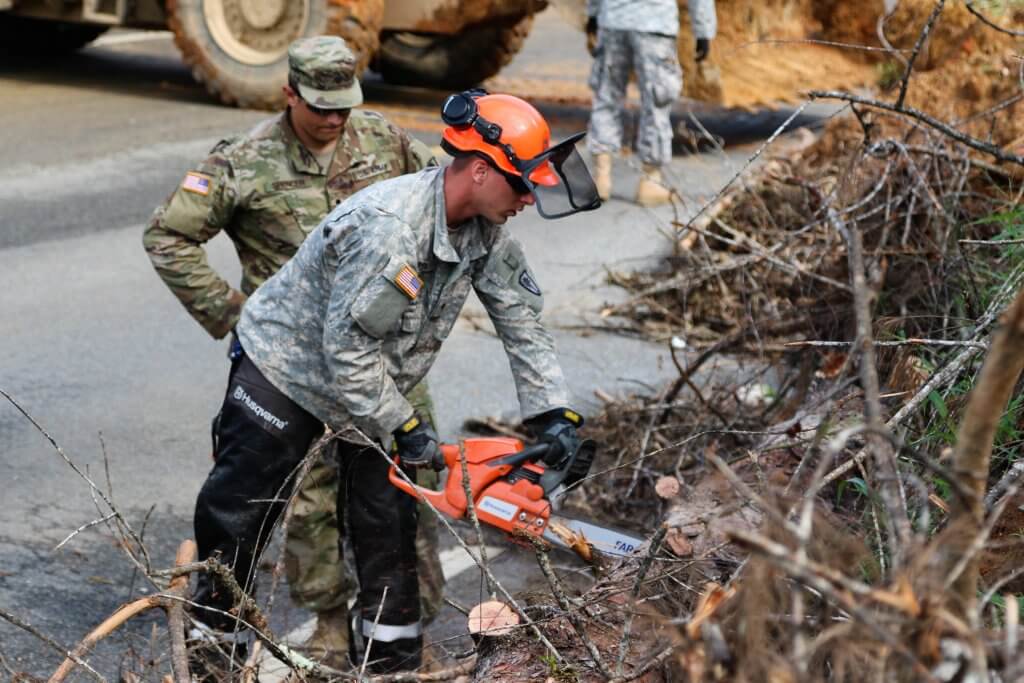National Guard leaders in Puerto Rico and Louisiana say they have worked hard to prepare for what researchers predict will be the seventh consecutive hurricane season with above-normal activity.
The first hurricane of the season, Hurricane Agatha, made landfall in Mexico on May 31. Hurricane season officially starts June 1 and ends Nov. 30.
The National Oceanic and Atmospheric Administration’s Climate Prediction Center has forecast a likely range of six to 10 potential hurricanes (with winds of 74 mph or higher), including three to six major hurricanes of category 3, 4 or 5 (with winds of 111 mph or higher).
Colorado State University researchers have forecast hurricanes since 1984 and had a similar prediction with nine hurricanes, four of them major.
Phil Klotzbach, a research scientist at Colorado State’s department of atmospheric science, said the prediction is based on close monitoring of water temperatures and atmospheric pressure. Hurricanes form when warmer-than-normal temperatures cause wind changes at 20,000 to 30,000 feet in the atmosphere.
Since 1995, hurricane activity in the United States generally has been “pretty busy,” Klotzbach said.
Typically, Florida and Texas are most hit by hurricanes, mostly due to their lengthy coastlines. But in the past two years, “Louisiana has really been run through the ringer” with hurricanes Laura and Delta in 2020, and Hurricane Ida in 2021, Klotzbach said.
Prepare for the worst-case scenario
The Louisiana National Guard usually partners with local authorities for emergency response. But in the wake of the last three hurricanes, it partnered for the first time this year with two Title 10 installations – Fort Polk Army Base and Barksdale Air Force Base – said Col. Aaron Duplechin, J-5 for the LNG.
No matter the hurricane experts’ forecast, the mission is to always prepare for the worst-case scenario, Duplechin said.
Strategic plans and exercises are assigned as early as November. A large exercise took place in April at multiple sites throughout Louisiana and included coordination of high water, aviation and boat search and rescue; commodities distribution; interoperability of communications systems; and cyber training, Duplechin said.
The Louisiana Guard also hosts an all-hazards coordination workshop designed to identify capabilities and shortfalls ahead of the next hurricane season, Duplechin said. All 54 states and territories were invited to this year’s workshop in March in New Orleans, the first held in-person since the COVID-19 pandemic began.
Attendees assessed how many transportation units and aviation assets would be needed and how units are going to be mobilized and deployed, Duplechin said.
The most complex piece is coordination with Louisiana’s 64 parishes — the equivalent of counties — which have vastly different levels of resources. Much of the work entails helping people who are unable to evacuate, and as the season progresses, those who are unwilling to keep doing so, Duplechin said.
“That’s potentially when you have a real catastrophe,” he said.
Hurricane Maria ‘completely changed’ emergency response
After the nearly cataclysmic destruction of Hurricane Maria in 2017, Puerto Rico has been spared by hurricanes in the past few years. Still, the PRNG has been actively preparing to face the next one, Maj. Gen. José Reyes said.
Hurricane Maria “completely changed” the PRNG’s emergency response planning, said Reyes, also Puerto Rico adjutant general.
RELATED: Fort Hood soldiers receive award for Hurricane Ida humanitarian mission
For example, equipment was acquired for areas that didn’t have emergency communications after it became clear that satellite phones are not effective because they only work if both parties are outdoors, Reyes said.
Before Hurricane Maria, Puerto Rico was divided into four emergency task force response areas. Now there are five to account for the large metropolitan area with 1.4 million residents, or nearly half the population, Reyes said.
‘Hurricane rehearsal of concept’
Every year, Puerto Rico and the U.S. Virgin Islands take part in a “hurricane rehearsal of concept” hosted by the U.S. Army North, Reyes said. This year’s scenario in May at Joint Base San Antonio-Fort Sam Houston included three back-to-back major hurricanes with landfall in Mississippi, Alabama, Texas, Puerto Rico and the U.S. Virgin Islands. A plan of action was developed to assign assets from different installations beginning 120 hours pre-landfall, Reyes said.
There’s also a yearly all-hazards coordination meeting in Washington, D.C., during which National Guard directors of operation from all 54 states and territories identify their vulnerabilities and emergency requirements during disasters, Reyes said.
Reyes said he’s “very confident” in PRNG’s preparedness for category 1 and 2 hurricanes. For more severe hurricanes, there are detailed plans for transportation and aviation asset support from other states. Additional Sikorsky UH-60 Black Hawk helicopters would come from New York, North Carolina and Florida, he said.
PRNG also has conducted tabletop exercises with all its 78 municipalities for earthquakes, tsunamis and hurricanes, Reyes said.
The night of Hurricane Maria, Reyes said, he was in an area that suffered the first casualties after it overflowed with up to 7 feet of water.
“The people suffering — the lives and property — it’s really bad,” he said.
Overall, Puerto Rico was at 96% mission capable equipment in June, and 98% for rolling stock for hurricanes. Its 36 water purification systems were 100% operational, he said.
“Hopefully we don’t have to live through another one,” he said. “But in case we do, we are ready.”
Duplechin agreed.
“That’s the art of what we do,” he said. “We’ve done our exercise, we’ve checked our equipment, we’ve pre-staged equipment and commodities, so whenever hurricane season rolls in, we’re ready.”

